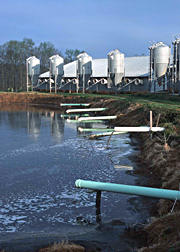|
Read the
magazine
story to find out more. |
|

Positioning farm buildings for raising pigs
perpendicular to prevailing winds could help reduce odors from downwind lagoons
or tanks, according to preliminary findings from ARS wind tunnel studies.
Photo courtesy of Natural Resources Conservation
Service.
|
|

|
A Model Farm for Emissions Studies
By
Ann Perry September 17, 2008
Anyone downwind of a pig barn knows that animal production facilities
generate some notable emissions. Now Agricultural Research Service (ARS)
scientists have reported that preliminary findings from wind tunnel studies
indicate that positioning farm buildings perpendicular to prevailing winds
could help reduce odors from downwind lagoons or tanks.
Wind speed and direction, topography, structures, facility management,
climate and vegetative cover all influence airflow--and influence where these
agricultural emissions end up.
ARS scientists
Tom
Sauer and
Jerry
Hatfield are using a wind tunnel to model how air emissions from animal
production facilities travel across the landscape. They embarked on a 3-year
study to see how the location and placement of buildings and waste-storage
facilities affects the transport of odor constituents like ammonia and hydrogen
sulfide.
The scientists, who both work at the ARS
National
Soil Tilth Laboratory in Ames, Iowa, used a 40-foot wind tunnel for their
research. The “wind” was produced by a blower at one end of the
tunnel that generated maximum wind speeds of 30 miles per hour.
Sauer and Hatfield built a test “farm” in the wind tunnel
that had scale replications of swine finishing units, aboveground slurry tanks
and lagoons. They arranged four of these model buildings on their
“farm” in several different configurations with the model storage
tanks.
The team also set up obstacles in the tunnel to create a surface
boundary layer of air that would mimic the effects of the Earth’s
atmospheric boundary layer. This helped to generate air turbulence which then
flowed through and around the obstacles. Water vapor or smoke from dry ice
substituted for ammonia and hydrogen sulfate emissions.
The researchers found buildings situated perpendicular to airflow
disrupted the downwind airflow to a greater extent than buildings that were
parallel to the airflow.
These findings also show that producers could derive a direct and
permanent benefit of improved air quality with just the one-time cost of
figuring out the best building placement.
Read more
about the research in the September 2008 issue of Agricultural Research
magazine.
ARS is a scientific research agency of the
U.S. Department of Agriculture.